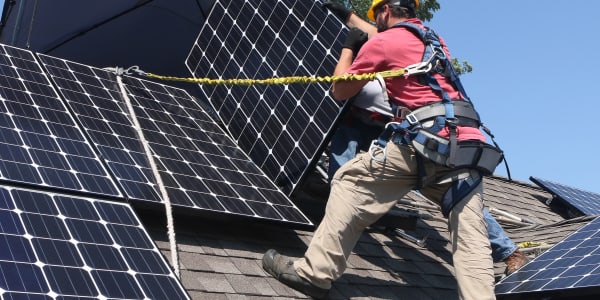A buyer's guide for futurists
Over the last quarter decade, advancing technology, prices and other trends have vastly changed consumers' purchase landscape. Cell phones were barely a blip on the radar, let alone the smartphones that almost 60 percent of American adults now use, to the tune of $189.2 billion in revenue a year (per the CTIA). Shoppers have also seen the advent of GPS, hybrid cars and social media and the decline of the CD, dial-up Internet and video rental stores.
The next 25 years, experts say, are likely to herald changes that are just as big. "We were promised flying cars, and what we got was [Twitter's] 140 characters or less," said Jack Plunkett, chief executive of Plunkett Research. "Clearly, we'll be in for a lot of surprises."
As cost and trends continue to drive innovation, there are products you'll see more of, some you'll see less of, and others that may fade away altogether. You'll be needing less and wanting more—and buying things you didn't even know you wanted, simply because technology will tell you so.
Here are 10 items you are likely to have on your shopping list in 2039—and some you will probably be crossing off.
—By CNBC's Kelli B. Grant
Posted 1 August 2014
Factory-direct goods
Supply chains to consumers are getting shorter. Take Everlane, a Web-only company that designs and manufacturers clothing with less markup than comparable high-end brands, said Jack Plunkett of Plunkett Research. "There's a lot of experimentation of that going on," he said. Down the line, consumers will see more opportunities to buy everything from clothing and furniture to gadgets and home goods directly from manufacturers—and even factories themselves—rather than through retailers. Online ordering and home delivery will make that easier, and more attractive amid rising prices.
Viagra
Chalk this one up to the graying population. By 2040, 25.1 percent of the population will be age 60 and older, up from 18.4 percent in 2010, according to the government's Administration on Aging. Consumers are likely to see more ads for the little blue pill and its ilk, with companies focusing on new products in that category to gain share in a growing market, said Richard Ebeling, a professor of economics at Northwood University. "Older people, they're not always 'on top of their game,' and those medications are going to matter," he said.
Meat
Expect to eat less beef, pork and chicken. "The rising demand for meat is going to be very dramatic," said Plunkett Research's Jack Plunkett, due to the growing middle class in countries such as India and China.
It's having an impact on prices already: Ground beef prices in May 2014 were up 16.5 percent from a year earlier, according to the Bureau of Labor Statistics. Over the same period, steak prices were up 17.2 percent, bacon 18.8 percent and pork chops 15.6 percent, among other big jumps. With the potential for more big hikes in the future, he said, shoppers' budgets in 2039 and beyond may not allow for much meat consumption.
"We're going to see some more interesting alternatives," said Teri Gault, founder of The Grocery Game. Soy-based proteins will likely be big players, she said, and some manufacturers are already toying with high-protein powders using, believe it or not, insects.
Smarter connected tech
Cutting-edge devices are already loaded with sensors. But future sensors will anticipating your needs and actually react to the data it harnesses. "The next big push is, 'If this, then that,'" said Shawn DuBravac, chief economist and director of research for the Consumer Electronics Association. This new technology will make for a more seamless tech experience.
For example, a smart shirt (like the one Intel introduced this year that tracks the wearer's vitals) would nudge the thermostat to boost the air-conditioner when it notices you're hot. Maybe even before you notice you're hot. Your smart refrigerator will alert you when food has gone bad and track the items you need to replenish. "That opens up a huge swath of products," DuBravac said. "What do I want to own, or digitize, that can anticipate my needs?"
Lab-made diamonds
Popping the question in a quarter decade might involve a diamond or other gem grown in a lab rather than in the ground. "We're seeing diamond deals who have only sold natural diamonds starting to sell lab-grown stones, because they see there's absolutely a market for it," said gemologist Antoinette Matlins, author of several diamond and gemstone buying guides.
The attraction could grow as large, flawless natural stones get pricier. Already, a lab-grown stone can be cheaper by more than half. Processes are also getting more advanced, making it cheaper to buy gems that are, already, virtually indistinguishable from those formed in nature, she said.
Cars
More consumers may be able to get by without one. As a side effect of the driverless car, car- and ride-sharing services a la Zipcar or Uber will be a cheaper and more effective way to travel, said the Consumer and Electronic Association's Shawn DuBravac. Even today, shippers such as UPS optimize their delivery path to minimize left turns and traffic, technology that a driverless car-sharing service would take advantage of. "There's always going to be a car going in the same direction as you're going in," he said.
Microhousing
How much space do you really need, anyway? So-called microunits—studio apartments that encompass just a few hundred square feet—have been gaining traction in cities, including New York and Washington, D.C. "Some individuals are willing to trade off a more compact unit in exchange for a highly desirable location," said Charles Hewlett, managing director of Robert Charles Lesser & Co. in Bethesda, Maryland. Although such housing is unlikely to pop up in suburban markets and urban areas, where real estate is more affordable, he said, in the future more city dwellers might opt for such a unit as a way to reduce costs early in life.
Or it may be the option of choice late in life. The trend could also extend to senior housing or retirement and assisted-living communities as a way to reduce costs, said Northwood University's Richard Ebeling.
Smartphones
Almost 60 percent of American adults have a smartphone, according to the Pew Internet Project. In another 25 years, though, the appeal of having one may be somewhat less, with the advent of smart watches, Google Glass-like products and other wearable tech, said Consumer and Electronic Association's DuBravac. As more surfaces are used as displays, that will further limit the need for a device with its own sizable screen. "It's not clear to me that we'll need a smartphone," he said. "We'll have connectivity through these other devices."
Water
"We're going to see a new line item on our budget: potable water," said The Grocery Game's Teri Gault. "People who don't buy drinking water now, will." By 2030, forecasts The World Bank, there will be a 40 percent shortfall of drinking-water supply relative to demand. But we won't still be buying bottled water the way we do now, said Plunkett Research's Jack Plunkett. Manufacturers are already moving toward packaging that's less wasteful—buyers will likely use refillable containers. "The disposable society is there, but it is lessening," he said.
High-tech foods
Many shoppers have been reluctant to accept foods that have been genetically modified—last year 93 percent of respondents in a New York Times poll said they think GMO foods should be identified as such on their labels. But genetically modified or engineered produce and meat are likely to be more common in years to come, with such technologies playing a role in boosting supply (and keeping prices low) amid growing global food demands, said Plunkett. "We're going to see demand- and price-driven acceptance," he said.





